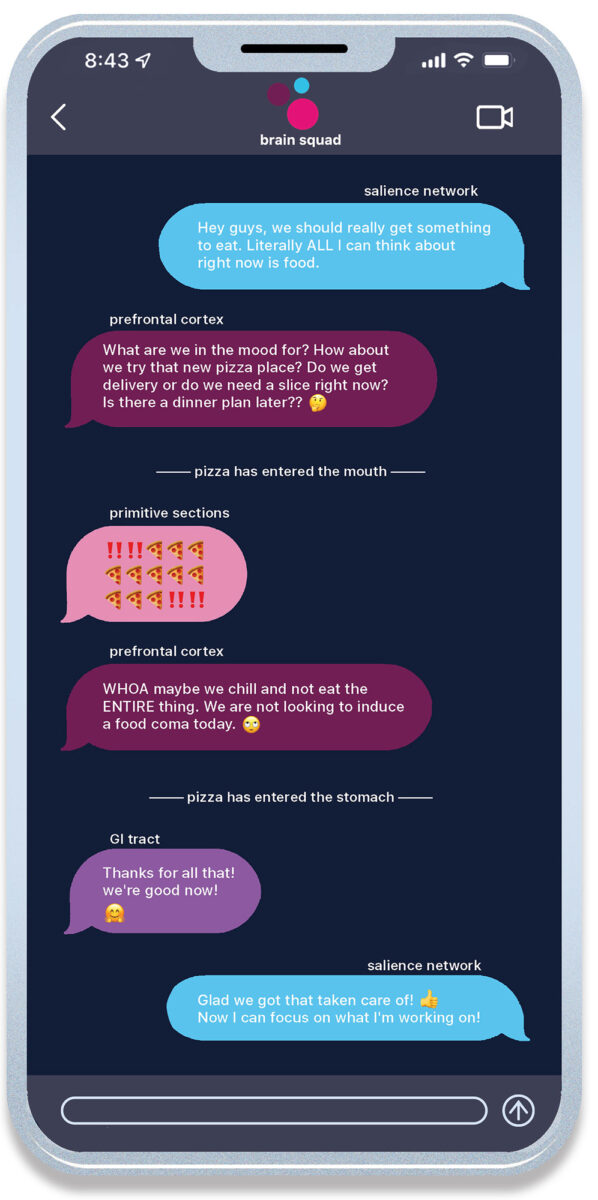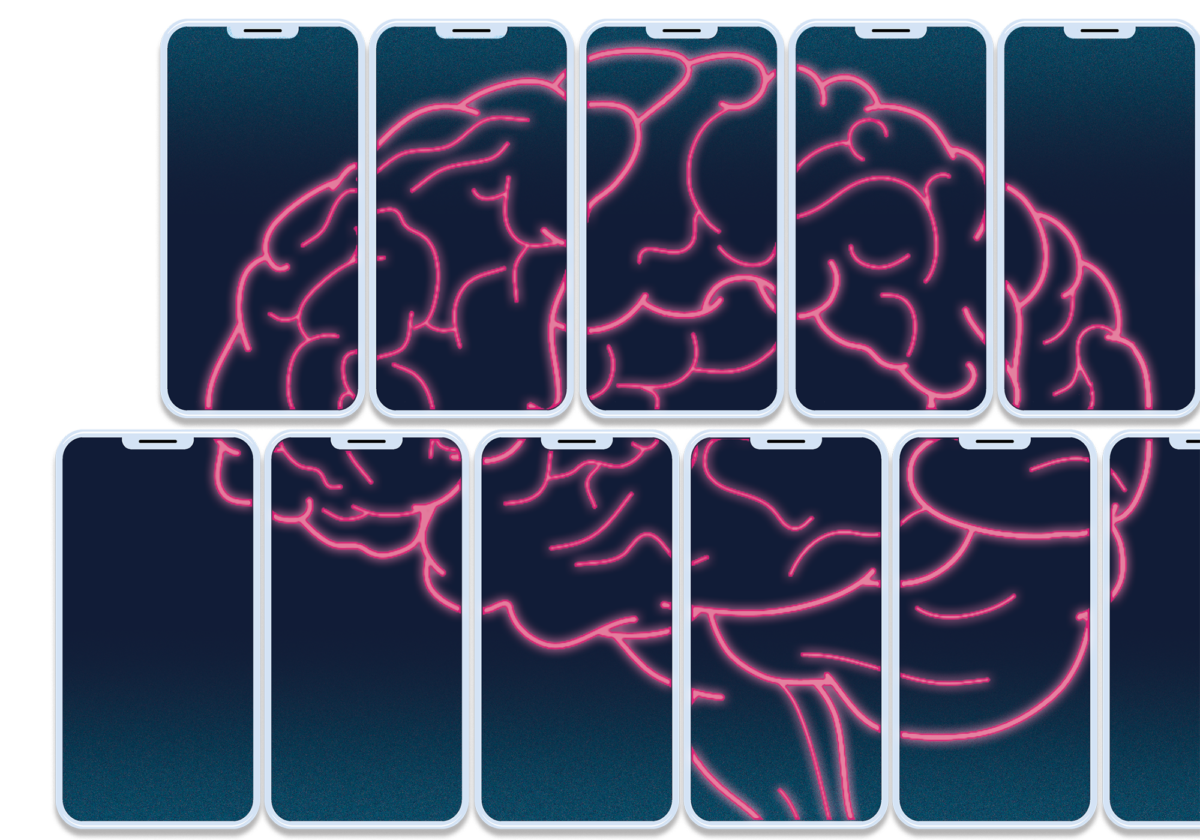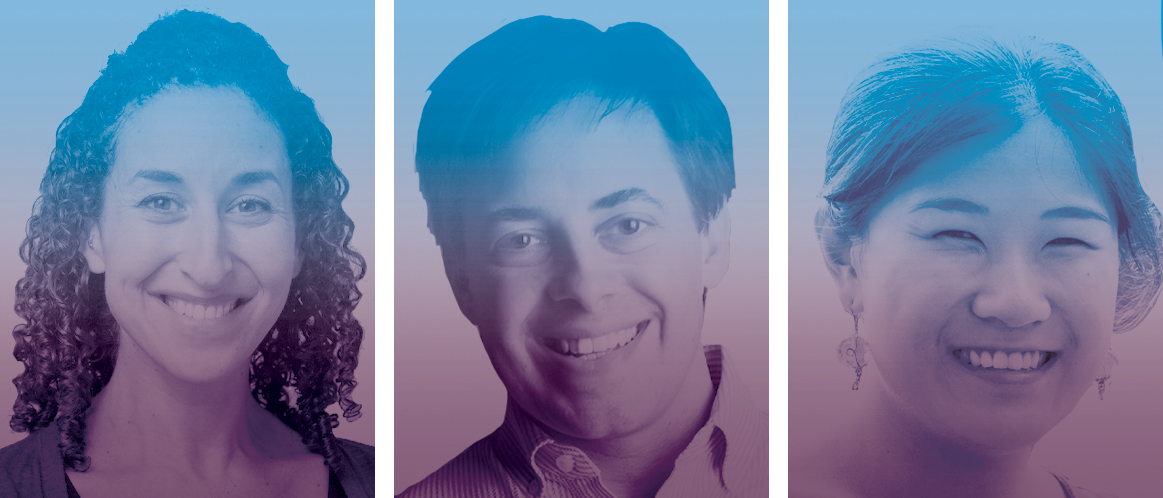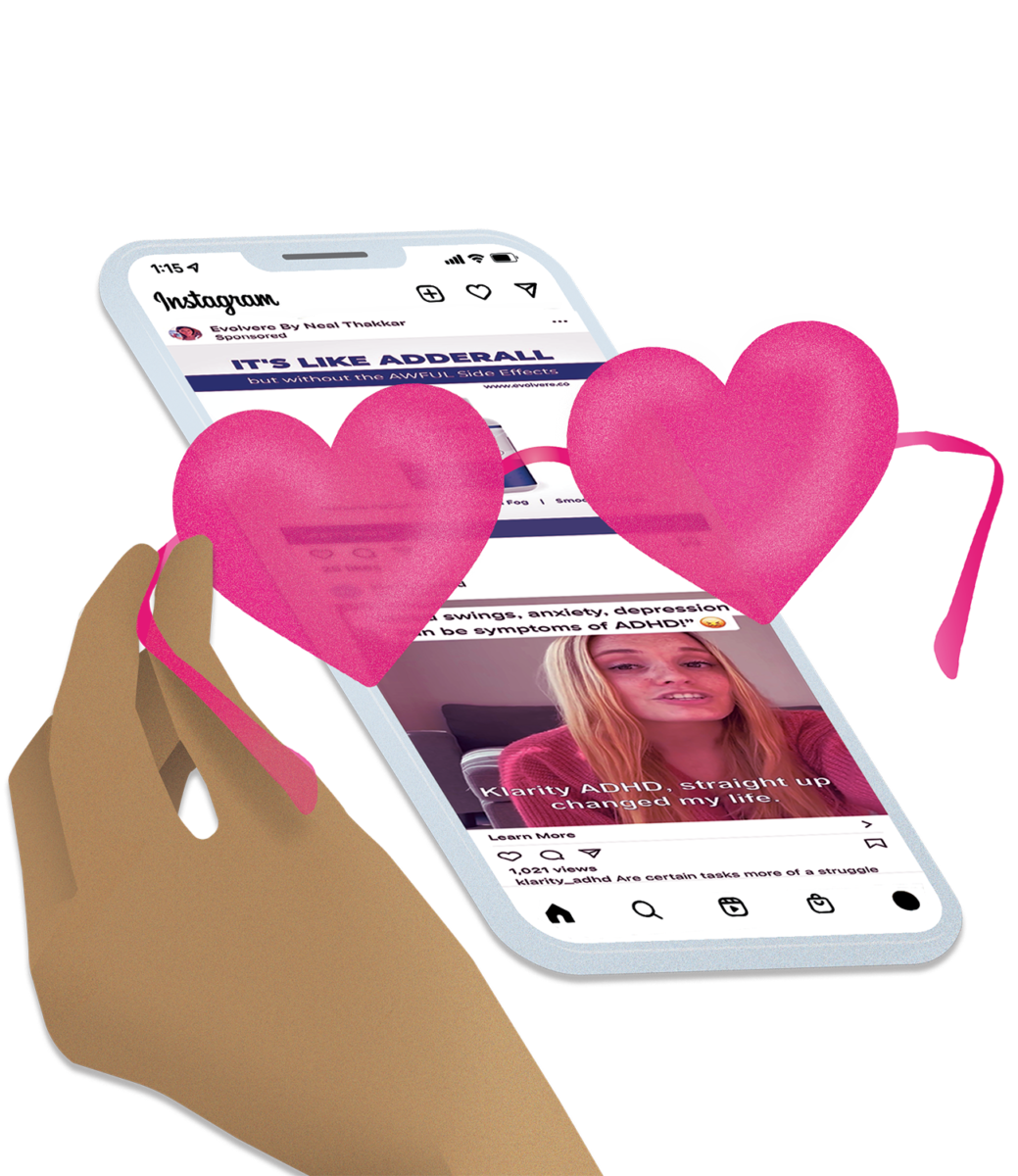The New Drug of Choice

Would you hand your 12-year-old a drug you knew was addictive, something that could disrupt sleep patterns and concentration, alter social behavior and decrease the desire to exercise? Would you give this drug if it could rewire their brains?
A lot of parents are handing this drug to kids. It’s called a smartphone, neurology and psychology researchers at Carolina have concluded.

Illustration by Haley Hodges ’19
Maybe “phone addiction” isn’t news to those of us hopped up on Twitter or TikTok, scrolling mindlessly as we “relax.” Or maybe we think it’s a benign obsession, like when a child is hooked on a sport or books or learning a musical instrument. Not quite. Passion for a hobby or profession is not the same as addiction, and researchers worry that addiction is particularly dangerous when the brain is changing so dramatically during adolescence.
“Aside from the first year of life, the years around puberty are the most important time for brain development,” said Mitch Prinstein, the John Van Seters Distinguished Professor of psychology and neuroscience. He teaches a course at Carolina on teens and technology with Eva Telzer, an associate professor, and with teaching assistant professor Rosa Li.
Teenage years are when we train our brains for adulthood. Many parents have decided it’s okay to hand kids electronic devices, essentially enrolling them in an uncontrolled experiment on the effects of technology and social media on brain development, said Jim Winston Jr. ’81 (’92 PhD), a practicing psychologist and parent of two adolescent boys.
Winston said this experiment is having disastrous consequences. His initial response came in 2018, when the Winston Family Foundation, of which he is one of five family directors, donated $3 million to Carolina. The funding supports Prinstein and Telzer to research the effects of technology and social media on brain development, a college course on teens and tech, and a website, teensandtech.org, that provides the latest science on the effects of technology and social media on the brain.
This year, the foundation gave Carolina an additional $10 million for the creation of the Winston National Center on Technology Use, Brain and Psychological Development. Co-directed by Prinstein and Telzer, the center is expanding the three core initiatives: research, curriculum development for students of all ages and outreach to parents.
“I’m horrified and ticked off at what smartphones and social media are doing to kids,” said Winston, who has decades of experience helping people battle addiction. “I think tech and social media companies are weaponizing what they know to be addictive products. And they are doing this for profit.”
“I want parents to know, when they give a phone to their child, there is the distinct possibility the kid will be incapable of reading a 400-page book at age 30. … I mean, neurobiologically, they’ll be incapable. Their brains will have been so rewired for hyper distractibility that keeping their attention fixed long enough to read a book will be impossible.”
—Jim Winston ’81
Neurobiologically incapable

Jim Winston ’81
Smartphones were originally designed to add conveniences, efficiencies and capabilities to life. Then came social-media platforms, which allowed for people to connect and express themselves online like never before, to build communities and audiences, to find and share news quickly and even to create successful businesses.
Emerging research, however, shows some not-so-good effects, such as cyberbullying, depression, anxiety, sleep disruption, unrealistic expectations and addiction.
“Social media is not pure evil,” Prinstein said. “The effects of social media will be different for every kid. But are social media apps designed to be addictive? Yes. Do they capitalize on vulnerabilities in the developing brain that should make us more scared for adolescents than any other age group? Yes.”
Now, with thousands of apps and games and ubiquitous social-media platforms, Winston said smartphones entice users to engage as much as possible, usurping attention from important aspects of life and increasing risk of attention-deficit disorders and addiction.
“I want parents to know, when they give a phone to their child, there is the distinct possibility the kid will be incapable of reading a 400-page book at age 30,” Winston said. “They won’t be lazy or unwilling or stupid. I mean, neurobiologically, they’ll be incapable. Their brains will have been so rewired for hyper distractibility that keeping their attention fixed long enough to read a book will be impossible.”
Prinstein and Telzer share Winston’s concern. No known research has followed children over the course of adolescence and through the teenage years to detail tech and social-media effects on the brain and behavior. The Winston national center is changing that. “We want to be the place people go to seek out the most state-of-the-art science in this area,” Telzer said.
Her lab has already shown that when it comes to children’s brains, social media is far from benign.
The likes alone changed how the kids’ brains processed the image. They focused on the likes instead of the fact that poison berries will make you sick and a bear could kill you.
Our brains on tech
The brain is an absurdly complex network of neurons working together to keep humans as sane and functional as possible. Even something as simple as keeping our attention focused on what we are doing right now involves a suite of brain regions called the salience network. The salience network keeps our attention focused on the most important thing in our environment at a particular time. For example, I’m focused on writing instead of the sun shining through the window or the dog barking or my phone staring at me, begging me to use it.

Illustration by Haley Hodges ’19
The salience network is activated, for instance, when we’re hungry because an empty stomach, at that given time, is the most salient experience. Then, the prefrontal cortex is engaged to respond at a higher level. Should I eat now? What should I eat? Where? How much? When is the next time I plan to eat? As we eat, the primitive areas of the brain fire in connection with dopamine and oxytocin brain cell receptors in response to pleasure. “Wow, this pizza tastes great!” And then our prefrontal cortex control center responds, “Yeah, but obviously do not eat the entire pizza.” Then, when we stop eating for several minutes, our GI tract communicates through neurons to our brain, and our salience network allows us to focus on something else, like work — or Instagram.
“It’s a gas-pedal, brake-pedal situation in our brain,” Winston said. When it’s out of whack, the consequences can lead to attention disorders, addiction, eating disorders and behavior problems such as anxiety. Winston is so concerned about the dangers of addictive technology in the hands of youth because smartphones can hijack the delicate balance between gas pedal and brake pedal.
To parse the power of the smartphone and its applications, Telzer’s lab started a study in 2018, enrolling 178 pre-teens and documenting their technology use and brain development over three years. At the start, scientists asked each child how much they accessed social media and categorized their use as frequent, moderate or infrequent.
The researchers then used functional magnetic resonance imaging, or fMRI, to measure the brain activity of the participants while they performed simple tasks such as naming a shape like an oval or a square. The child was shown a smiling face of a teenager, if he or she completed the assignment in the allotted time, or a frowning face, if the child was too slow. (The allotted time was arbitrary.) The researchers conducted fMRI tests again a year later and then a year after that.
Telzer found increased levels of activity in the salience networks of the frequent social-media users when they were shown faces of approval or disapproval. She also found increased activity in the prefrontal cortex, the region that would tell the kids “enough is enough.”
“This is only one study,” Telzer said, “but it implies these sorts of stimuli — the reward and punishment faces — are becoming more salient to the adolescent.” As a result, Telzer said she believes the prefrontal cortex is becoming more engaged than usual as it responds to the increased salience activity. But, as Winston would say, the gas pedal is winning.
Other researchers conducted fMRI studies in which children were shown pictures of a bear and poison berries. As expected, a part of their primitive fight-or-flight-brain region lit up, signaling a healthy survival response to danger. But when researchers added a bunch of “likes” — an image of a heart or thumbs up typically used by social media platforms — in the corner of the same picture, the salience region became more active while the prefrontal cortex dimmed. The likes changed how the children’s brains processed the image, the scientists concluded. The participants focused on the likes instead of the fact that poison berries can make you sick and a bear can kill.
“That’s how powerful social media is,” Winston said. “It’s like the instinct for community acceptance is as powerful as hunger.”
Some social media platforms experimented with decreasing their dependence on the system of likes, but users told the companies they wanted to keep the symbols. The companies backed down, an interesting response, considering that vocal critics might have been addicted to social media.
The epiphany

Illustration by Haley Hodges ’19
Winston is a psychologist who’s worked with people from all walks of life, including people addicted to drugs in a federal prison in Butner. He knows what addiction looks like, what it can do to individuals and families and how sneaky it can be. “Over 30 years practicing, I’ve learned that the earlier people develop addictive patterns, the more difficult their life course is,” he said.
About six years ago, Winston walked his sons into a Miami school and saw before him a sea of kids, their faces buried in their smartphones. A few kids bounced off Winston, oblivious to his presence, captive to their screens. Winston said the scene astounded him. Soon after, he began poring over research on the effects of technology. He came across a book by Nicholas Carr, The Shallows: What the Internet Is Doing to Our Brains. Carr argues the internet is changing how our brains function, and not for the better.
Winston learned that children are relating to each other much more through technology than ever before. Empathy is down 40 percent, according to researchers at the University of Michigan. Kids are not learning how to read people’s expressions by simple eye contact, according to UCLA researchers. “They send messages through apps and social media without understanding the impact of those messages,” Winston said. Kids are now highly distractible and often without fully comprehending it.
Winston’s research revealed an increase in adolescent anxiety, depression and suicidal ideation. “I can’t prove a causal effect between cellphone use and these things,” Winston said. “But when you see youth cellphone ownership pushing above 50 percent, and you see all these psychological variables, it’s not hard to intuitively and deductively see the use of phones as a main contributor.”
So, what do we do?
“No one will be shutting down social media,” Prinstein said. “That horse has left the barn. But I think we’re at a choice point: Do we want to use this brilliant tech to enhance child development and use science to teach kids really helpful life lessons? Or will we be driven by the desire to make a profit? Maybe there’s a way to do both. But right now it feels very, very skewed toward the profit motive.”
As Big Tech makes money, Winston is spending his. And he’s doing so at Carolina because he said this place is in his blood, and Carolina has the expertise and desire to be a big part of the solution.
This is when students get it, if they hadn’t gotten it already: why would technology companies make their apps and social media platforms free? … They want to capture your attention as easily as possible.
A long legacy

Eva Telzer, Mitch Prinstein and Rosa Li
Six generations of Winstons have attended Carolina, including George Tayloe Winston, University president from 1891 to 1896. Jim’s father, James Horner Winston ’55, donated money in 2004 to establish the Winston House for the UNC European Study Center in London.
Jim’s father was a real estate investor, and when he died in 2018, he bequeathed nearly all of his fortune — about $100 million — to create the Winston Family Foundation.
“We were all shocked at the amount,” Winston said. “My father was old school, thought money corrupted people. He lived way, way below his means. We had no idea how much money he had.”
The foundation focuses on education and the arts. Winston already was obsessed with researching the effects of technology on kids’ brains by the time his father died. Shortly after, he contacted Carolina in 2018 to meet with Kevin Guskiewicz, dean of the College of Arts and Sciences at the time and now UNC chancellor. He also met with Prinstein and Telzer, whose research on mental health and adolescent brain development had established them as national experts.
After the meeting, the foundation donated $3 million to establish the Winston Family Initiative in Adolescent Brain Development and Technology, which allowed Telzer to start her three-year fMRI study and for the College of Arts and Sciences to create a new course, “Social Media, Technology and Adolescent Development,” which was first offered in the 2020 fall semester. Prinstein and Telzer taught the inaugural class of 240 students. Li, hired as an instructor through the initiative, taught a 60-student section.
ALCOHOL, GAMBLING —
AND SOCIAL MEDIA?
The Diagnostic and Statistical Manual of Mental Disorders contains an 11-question diagnostic tool to determine the severity of a substance or gambling addiction. Rosa Li, a teaching assistant professor in the department of psychology and neuroscience, substitutes “social-media use” for “alcohol or drug use” in the questionnaire and asks her students, unaware of the change, to take the test, which appears below. Most of Li’s students qualify for mild or moderate addiction to social media and some for severe addiction. Li cautions that this is merely an illustrative exercise; the DSM does not list technology addiction as a disorder, but it says it is worthy of further study.
- Social media is often consumed in larger amounts and/or over a longer period than the patient intended.
- Persistent attempts or one or more unsuccessful efforts made to cut down or control social media use.
- A great deal of time is spent in using social media or recovering from its effects.
- Craving or strong desire or urge to use social media.
- Recurrent social media use resulting in a failure to fulfill major role obligations at work, school, or home.
- Continued social media use despite having persistent or recurrent social or interpersonal problems caused or exacerbated by the effects of social media.
- Important social, occupation, or recreational activities given up or reduced because of social media use.
- Recurrent social media use in situations in which it is physically hazardous.
- Social media use is continued despite knowledge of having a persistent or recurrent physical or psychological problem that is likely to have been caused or exacerbated by social media use.
- Tolerance, as defined by either markedly increased amounts of social media needed in order to achieve desired effect, OR markedly diminished effect with continued use of the same amount of social media.
- Withdrawal, as manifested by either the characteristic withdrawal syndrome, OR social media used to relieve or avoid withdrawal symptoms.
Severity Codes
Mild: 2 to 3 symptoms
Moderate: 4 to 5 symptoms
Severe: 6 or more symptoms
The symptoms are similar for other substance use disorders (except caffeine), except that withdrawal does not apply for all substances.
Li breaks down her course into four sections: the science of the adolescent brain, tech and peer relationships, tech and the brain, and tech and mental health. She focuses early in the semester on the ways technology companies are capitalizing on the reward system in the adolescent brain. Later, she asks students to invent ways to make apps more engaging so they hold users’ attention for as long as possible.
Li said this exercise is when students get it, if they hadn’t gotten it already: Why would technology companies make their apps free? The companies have answers. Facebook, for instance, says they charge companies to put ads on our Facebook pages, which keeps their app free and available to everyone. But 4,000 pages of documents from 2011 to 2015 leaked to NBC News show that Facebook used our data— including photos and information we post online — as leverage in negotiations with companies that advertise on the platform. What companies can and cannot do with our data is found in the “terms of service” we agree to, often without reading them.
Deep into the semester, with students realizing social media is something to take seriously, Li gets crafty with her own experiment.
In psychology, the Diagnostic and Statistical Manual of Mental Disorders, or DSM, is the authoritative source for what is considered a mental illness. It contains an 11-question diagnostic tool for substance use disorder and gambling addiction. If you answer two or three questions affirmatively, then you have a mild addiction. If you answer yes to four or five questions, then you are moderately addicted. Answer affirmatively to more than six, you have a severe addiction.
Without telling her students she’s using the DSM addiction criteria, Li swaps out “alcohol or drug use” with “social-media use” and has the students answer the 11 questions before reporting the number of questions to which they answered “yes.” Then she tells them they just took the official DSM test for addiction.
The DSM does not list a “technology addiction disorder.” But the manual includes a line about tech addiction being worthy of further study, a teaser that it might be included as a disorder in a future DSM edition, said Prinstein, who serves as the chief science officer for the American Psychological Association, which publishes the DSM.
Li said most of the students qualify for mild or moderate addiction and some for severe addiction. They also told Li they get irritable or anxious if they stop accessing social media for a while, which are signs of withdrawal in other addiction disorders.
This exercise, and others in the class, excite the students, Li said. Some set up chat groups to discuss the course work and to set up debates — a positive use of social media, according to Prinstein. Several UNC students formed an organization called Students for More Humane Technology — an old-school method of social connectedness.
In his 23 years teaching at Yale and UNC, Prinstein said, “it’s the most engaged I’ve ever seen college students. I’ve never seen students form a club based on a class. Usually they take the final, and we’re done. But they want to keep the conversation going. They want to stay active.”
It’s also one of the most popular courses in a popular major at Carolina. The 300 seats in two sections fill in five minutes when the University opens classes for registration, Prinstein said. The class is an elective mostly reserved for first- and second-year students.
Carolina senior Ben Dameron took the course in spring 2021, and he said it’s the reason he joined Telzer’s Developmental Social Neuroscience Lab as a research assistant. Dameron said he had a love-hate relationship with social media before coming to Carolina and wants to continue working in the field after graduation, which may include helping address mental health problems associated with social media use or joining a social media company’s ethics team.
“My main concern is the role technology plays in the polarization of society,” Dameron said. “People are living in different realities. And social media companies are trying to get us to stay on their sites as long as possible.”
The science of regret
As part of the first Winston initiative in 2018, Li co-created a course for middle school students with Kelley Brill, a STEM and technology instructor at the Miami Country Day School in Florida, which offers the course to seventh and eighth graders. Li said she brings the science piece, and Brill can reach kids of this age. The students keep a journal about how they feel when they use social media or when they go a day without it. This exercise opens the students to the idea that technology is not benign, Li said.
At Country Day, the only seventh grader without a smartphone is Jim Winston’s child, who has an old-style flip phone, which doesn’t have internet access and can only send text messages. The kid is embarrassed by it and has asked his father why he can’t have a smartphone.
“I told him, ‘Because I’m steeped in this issue, and I care about your brain, not your image,’ ” Winston said. “I know enough to set a firewall in the face of him being the only one in seventh grade without a smartphone.”

TikTok and Instagram allow companies to advertise “natural attention enhancers” and promote 30-minute online consultations where a licensed professional can prescribe medicines such as Adderall and Vyvanse, both ADHD treatments. Illustration by Haley Hodges ’19
But Winston is an outlier, at least in Miami. First, flip phones are becoming extinct. Second, smartphones are affordable super computing music libraries with three camera lenses and instant access to a wealth of human knowledge, plus streaming services, games and live sports. Brill and Li are now creating versions of their middle school curriculum for elementary and high school students.
Back in Chapel Hill, toward the end of each semester, Li, Telzer and Prinstein ask their students for feedback, how they view technology and social media and how they view their own experiences. “Invariably, they say they wish their parents hadn’t given them a phone at age 12,” Prinstein said. “They tell us, ‘I can’t concentrate. I can’t sleep. I’m wasting my time. I can’t study. I’m anxious when I talk to people in person.’ ” Most students realize they’re hooked. And they don’t like it.
For all of Winston’s passion, he knows he, Brill and researchers at Carolina are swimming against the current. His family’s foundation has donated $13 million; social media companies are worth billions of dollars.
“We need to shift the national narrative away from ‘this is just a phone,’ ” Winston said. “That’s bull. You are handing your kid an overstimulating device they are incapable of regulating, something that alters their brain. The whole effort here is to generate enough awareness to create a critical mass. It took 30 years to break through on cigarettes, and those things cause cancer. Our project might take a while, but we have to start somewhere.”
Mark Derewicz is a freelance writer living in Chatham County and the director of research and national news for UNC Health and the School of Medicine.
Thanks for reading the Carolina Alumni Review
Carolina Alumni members, sign in to continue reading.
Not yet a member? Become one today.
